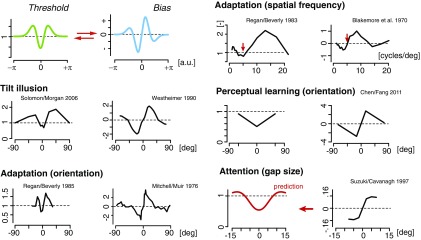Fig. 4.
Predicted and measured bias–threshold patterns induced by various forms of contextual modulation. Spatial context as in the tilt illusion (29, 30) [or using motion stimuli (31)] and temporal context during adaptation experiments [orientation (32, 33), relative to adaptor orientation; spatial frequency (34, 35), red arrows indicating the value of the adaptor stimulus] induce similar biases and changes in thresholds that are qualitatively well predicted (relative to the unadapted condition). The predicted relation seems to also hold for perceptual changes induced by perceptual learning (36) and spatial attention. Spatial attention has been tied to repulsive biases (37) at the locus of attention and is also known for improvements in discriminability, although little is known about how discriminability changes with stimulus value. All data curves are replotted from the corresponding publications. All data represent biases and changes in threshold (ratio) relative to the corresponding control conditions (no surround; preadapt; prelearn; nonattended).

